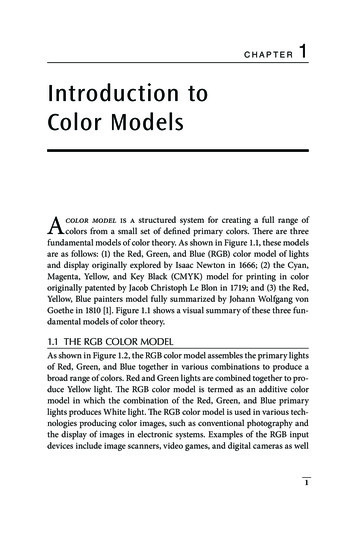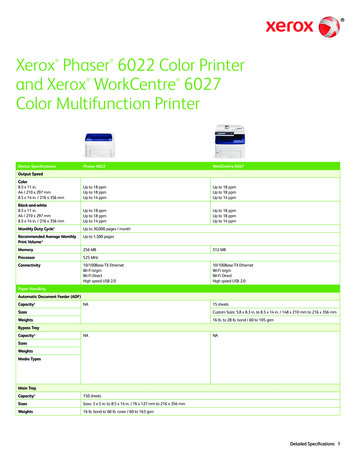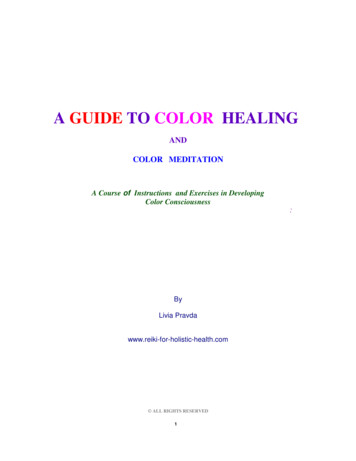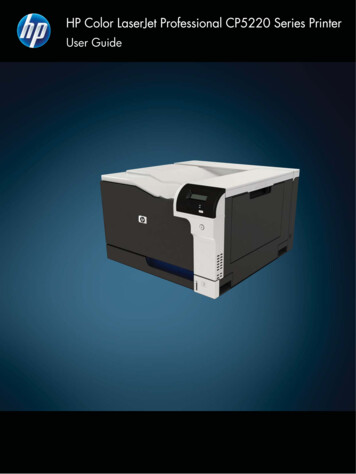
Transcription
CHAPTER1Introduction toColor ModelsAcolor model is a structured system for creating a full range ofcolors from a small set of defined primary colors. There are threefundamental models of color theory. As shown in Figure 1.1, these modelsare as follows: (1) the Red, Green, and Blue (RGB) color model of lightsand display originally explored by Isaac Newton in 1666; (2) the Cyan,Magenta, Yellow, and Key Black (CMYK) model for printing in colororiginally patented by Jacob Christoph Le Blon in 1719; and (3) the Red,Yellow, Blue painters model fully summarized by Johann Wolfgang vonGoethe in 1810 [1]. Figure 1.1 shows a visual summary of these three fundamental models of color theory.1.1 THE RGB COLOR MODELAs shown in Figure 1.2, the RGB color model assembles the primary lightsof Red, Green, and Blue together in various combinations to produce abroad range of colors. Red and Green lights are combined together to produce Yellow light. The RGB color model is termed as an additive colormodel in which the combination of the Red, Green, and Blue primarylights produces White light. The RGB color model is used in various technologies producing color images, such as conventional photography andthe display of images in electronic systems. Examples of the RGB inputdevices include image scanners, video games, and digital cameras as well1
2 Applying Color Theory to Digital Media and VisualizationVisually summarizing color modelsRGB adds with lights.CMYK subtracts forprinting.RYB subtracts tomix paints.FIGURE 1.1 Visual summary of color models. The Red, Green, and Blue (RGB)color model is an additive color model for displays. The Cyan, Magenta, Yellow,and Key Black (CMYK) color model is a subtractive color model for printing. TheRed, Yellow, and Blue (RYB) color model is designed for mixing colors with paints.(Images created by Theresa-Marie Rhyne, 2016.)FIGURE 1.2 Illustration of the RGB color model. (Image created by Theresa-Marie Rhyne, 2016.)as television and video cameras. RGB output devices encompass the broadrange of television-set technologies and video projector systems, alongwith computer and mobile phone displays. The RGB color model has asolid logic in terms of physics and the human perception of colors. Next,we provide a historical overview of this logic.
Introduction to Color Models 3In 1666, Isaac Newton explored the dispersion of White sunlight intoa rainbow of colors. His experiments involved holding a glass prism inthe path of sunlight coming through a hole in a dark room. The Whitelight split into Red, Orange, Yellow, Green, Blue (actually Cyan), Indigo(frequently referred to as Dark Blue), and Violet. Newton asserted thatdifferent colors combined to produce the White light. Newton publishedhis findings in a book entitled Opticks, in English, in 1704 [2]. Newton’srainbow color map for light has become the fundamental approach in thedesign of today’s visualization and digital media presentations. Newtonalso developed the initial concept of the color wheel that we will highlight in Section 1.4 of this chapter on color models. Although Newton didnot define Red, Green, and Blue as the primary colors, his research wasthe first step in showing that color lights combine together to producea broad array of additional colors. In Figure 1.3a, we diagram the conventional arrangement of what Newton defined as the dispersion of digoXPurplePlaAsol(a)BYTD(a) Rainbow diagram showing the conventional arrangement ofcolors (Red, Orange, Yellow, Green, Blue [actually Cyan], Indigo [Dark Blue], andViolet). (Based on Newton, I., Opticks: or a Treatise of the Reflexions, Refractions,Inflexions and Colours of Light, Samuel Smith and Benjamin Walford, London,United Kingdom, 1704. Image created by Theresa-Marie Rhyne, 2016.) (b)Redrawing of Isaac Newton’s diagram of the spectrum of light. (Adapted fromNewton, I., Opticks: or a Treatise of the Reflexions, Refractions, Inflexions andColours of Light, Samuel Smith and Benjamin Walford, London, United Kingdom,1704. Image created by Theresa-Marie Rhyne, 2016.)FIGURE 1.3
4 Applying Color Theory to Digital Media and VisualizationWhite light into a rainbow of colors. In Figure 1.3b, we show an adaptedversion of Newton’s original drawing of the spectrum of colors from hisbook Opticks in 1704. Newton’s notations in the diagram refer to an analogy he developed where the seven colors of the rainbow correspond to themusical concept of seven sound intervals displayed by an octave.The RGB color model was actually defined in regard to the theory oftrichromatic color vision. In 1802, Thomas Young, in a lecture entitled On theTheory of Light and Colours, postulated that each human eye had three typesof photoreceptors (today referred to as cone cells). Young further proposedthat each photoreceptor is sensitive to specific ranges of the visible light. In1851, Hermann von Helmholtz, in his book Treatise on Physiological Optics,added to the theory further by noting that the three types of cone photoreceptors are long preferring (Red), medium preferring (Green), and short preferring (Blue). We will highlight these color vision concepts further in Chapter 2.In 1861, during a lecture on his color studies at the Royal Institute in theUnited Kingdom, James Clerk Maxwell provided the first widely recognized demonstration of the RGB color model as well as what is often calledthe first color photograph [3]. In his lecture, Maxwell showed an imageof a tartan ribbon photographed by a professional photographer on threeplates through Red, Green, and Blue-Violet filters, respectively. Combiningthese filtered images together onto a screen produced a reasonable colordisplay of the tartan ribbon. Figure 1.4 shows Maxwell’s demonstrationFIGURE 1.4 Image of a tartan ribbon that James Clerk Maxwell demonstrated inhis 1861 lecture on the RGB color model. This image is also considered the first colorphotograph. (From Maxwell, J.C., Br. J. Photogr., August 9, 1861, public domain.)
Introduction to Color Models 5that was revolutionary in 1861. This concept is now used in present-dayvideo projection systems and is fundamental in regard to television, video,computer, and mobile phone displays.1.2 THE CMYK COLOR MODELThe CMYK color model is designed to support color printing on Whitepaper. The CMYK color model is termed as a subtractive color model inwhich the starting point begins with a White or light surface. Color pigments reduce the reflection of the original White light. The color inks thussubtract from the original White surface. Typical output devices for theCMYK color model include color inkjet, laser, and dye-sublimation printers. Each device has its own particular technology for color image reproduction. Figure 1.5 shows the CMYK color model.Historically, for color printing processes to work, individual plates werecreated for the Cyan, Magenta, and Yellow (CMY) color pigments. Theplates were registered over top of each other to produce full color imagesand the process was called a three-color printing process. When the primary pigments of CMY were combined together as inks, in equally largeFIGURE 1.5 Illustration of the CMYK color model. (Image created by Theresa-Marie Rhyne, 2016.)
6 Applying Color Theory to Digital Media and Visualizationamounts, the result was a Black color. When color printing was put intopractice, combining the CMY inks together became an expensive processand, in some situations, certain papers were unable to absorb all of the inkrequired. As a result, the color printing process was modified to allow fora Black plate to support the printing of Black text and other Black elementswith the CMY printing plates being registered or “keyed” against the Blackplate. This color printing process and its associated model was thus termedthe CMYK color model. CMYK is thus a four-color printing process.Today, when a digital image is printed, the RGB numeric values of theimage are converted to the CMYK numeric values of a printer. In theory, the RGB and CMYK color models are complementary to each other.Various combinations of the Red, Green, and Blue primaries of the RGBcolor model produce CMY. The reverse is true for the CMY primarieswhere combinations of the CMYK color model produce Red, Green, andBlue. In practice, these combinations are not purely complementary sincethe RGB color model involves lights and the CMYK color model involvespigments. Colors selected and matched on an RGB mobile phone canappear with different intensity, perhaps even more subdued, when reproduced on White paper via a CMYK ink jet printer. Figure 1.6 shows thecomplementary relationship between the RGB and CMYK color models.Three- and four-color reproduction processes were first patented in 1719by Jacob Christoph Le Blon. Le Blon actually used Red, Yellow, and Blue(RYB) inks on individual metal plates with a Key Black registration plate asAdditive RGB color model:BI R G B WhBlackRedGreenBlueWhiteComplementry colorsWhiteCyanMagentaYellowBlackSubtractive CMYK color model:Wh C M Y BlFIGURE 1.6 Diagram of the complementary relationship between the RGB colormodel and CMYK model. (Image created by Theresa-Marie Rhyne, 2016.)
Introduction to Color Models 7the foundation for his color reproduction methods. Like the CMYK colormodel, the RYB color model is also a subtractive model. We will highlightthe RYB painters color model in the following section.1.3 THE RYB COLOR MODELThe RYB color model is a subtractive color model for mixing paintingpigments. It is usually the first color model that we learn at an early age,perhaps in kindergarten. Starting with White paper, RYB color pigmentswhen combined together yield Black, similar to the CMYK color model.Secondary colors that result from mixing primary pigments include thefollowing: (1) the combination of Red and Yellow to yield Orange, (2) thecombination of Yellow and Blue to yield Green, and (3) the combination ofBlue and Red to yield Purple. The RYB color model is used in the arts andarts education. Figure 1.7 shows the RYB color model.As discussed previously, Newton published his rainbow color mapfindings in 1704. During that period, production and reproduction ofcolor images was performed with paint pigments on a White or creamcanvas. Painters relied on the RYB color model for mixing and understanding colors. The theory of trichromatic (RGB) color vision had notbeen postulated. Although mirror displays existed, photographic, television, video, computer, and mobile display technologies with Red, Green,and Blue lights had not been developed. The RYB color model of the eighteenth century was the foundation of theories of color vision.FIGURE 1.7 Illustration of the RYB color model. (Image created by TheresaMarie Rhyne, 2016.)
8 Applying Color Theory to Digital Media and VisualizationAs a result, it was difficult for painters to understand how to incorporate Newton’s observation (dispersion of White sunlight into a rainbow ofcolors) into their working knowledge of the RYB color theory. Therefore,Newton’s observations were very misunderstood and frequently challenged by painters and other visual artists in the eighteenth century. It wasnot until the nineteenth-century developments of RGB color vision principles that the relationship between additive and subtractive color models,as shown in Figure 1.6, was understood. In the following section, we willhighlight the evolution of color theory based on the color wheel conceptsintroduced by Newton and later modified by eighteenth-century artistsand scientists.1.4 OVERVIEW OF THE HISTORICALPROGRESSION OF COLOR THEORYAs noted in Section 1.1, Isaac Newton developed the initial concept of thecolor circle or the color wheel. His diagram, shown in Figure 1.8, was published in his 1704 book, entitled Opticks. Newton transitioned individualspectral colors, observed in his prism experiments, into a closed colorcircle. He selected seven colors to correspond to the musical concept ofseven sound intervals displayed by an octave. Newton decisions on specific colors were based on aesthetic preferences rather than on scientificprinciples. He chose Red, Orange, Yellow, Green, Blue (actually Cyan),Indigo (frequently referred to as dark Blue), and Violet. Newton’s Opticksbook went on to become one of the most widely read scientific books ofthe eighteenth century. His rainbow color map concepts and establishment of the color circle or color wheel continue to influence us even today.In Section 2.11 of Chapter 2, we will highlight some of the difficulties inusing the rainbow or Newtonian color map as a default color scheme forcurrent visualization and visual analytics efforts.In 1766, over 60 years after Isaac Newton’s writings on the color circle, Moses Harris published his Natural System of Colours book. MosesHarris was an entomologist and engraver in England [4]. In his book,Harris described the RYB color model and demonstrated the wide variety of colors that resulted from combinations of the three primary colors. His observations built upon the writings of Newton as well as JacobChristoph Le Blon’s patented three-color separation printing process of1719. Harris was particularly focused on the classification of colors andthe relationships between specific colors. As a result, he made the firstknown published attempt to diagram the RYB color wheel. He defined
Introduction to Color Models 9ge FOranYqYellowrGRedEZpDAtoleVixGreensO ueBltvBIndigoCFIGURE 1.8 Adapted from Isaac Newton’s Color Circle diagram that appearedin his 1704 Opticks book. We have added color squares to highlight Newton’stext descriptions of colors noted in the circle diagram. (Adapted from Newton, I.,Opticks: or, a Treatise of the Reflexions, Refractions, Inflexions and Colours ofLight, Samuel Smith and Benjamin Walford, London, United Kingdom, 1704.Image adapted by Theresa
Introduction to Color Models 3 In 1666, Isaac Newton explored the dispersion of White sunlight into a rainbow of colors. His experiments involved holding a glass prism in the path of sunlight coming through a hole in a dark room. The White light split into Red, Orange, Yellow, Green, Blue (actually Cyan), Indigo (frequently referred to as Dark Blue), and Violet. Newton asserted that different .











